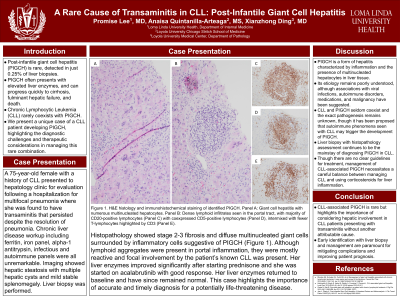Sunday Poster Session
Category: Liver
P1304 - A Rare Cause of Transaminitis in CLL: Post-Infantile Giant Cell Hepatitis
Sunday, October 27, 2024
3:30 PM - 7:00 PM ET
Location: Exhibit Hall E

Has Audio

Promise Lee, MD
Loma Linda University Health
Loma Linda, CA
Presenting Author(s)
Promise Lee, MD1, Anaisa Quintanilla-Arteaga, MS2, Xianzhong Ding, MD3
1Loma Linda University Health, Loma Linda, CA; 2Loyola University Chicago Stritch School of Medicine, Chicago, IL; 3Loyola University Medical Center, Chicago, IL
Introduction: Post-infantile giant cell hepatitis (PIGCH) is rare, detected in just 0.25% of liver biopsies. Chronic Lymphocytic Leukemia (CLL) rarely coexists with PIGCH. We present a unique case of a CLL patient developing PIGCH, highlighting the diagnostic challenges and therapeutic considerations in managing this rare combination.
Case Description/Methods: A 75 year old female with a history of CLL presented to hepatology clinic for evaluation following a hospitalization for multifocal pneumonia where she was found to have transaminitis that persisted despite the resolution of pneumonia. Chronic liver disease workup including ferritin, iron panel, alpha-1 antitrypsin, infectious and autoimmune panels were all unremarkable. Imaging showed hepatic steatosis with multiple hepatic cysts and mild stable splenomegaly. Liver biopsy was performed. Histopathology showed stage 2-3 fibrosis and diffuse multinucleated giant cells surrounded by inflammatory cells suggestive of PIGCH. Although lymphoid aggregates were present in portal inflammation, they were mostly reactive and only a small amount of focal involvement by patient’s known CLL was present. Her liver enzymes improved significantly after starting prednisone and she was started on acalabrutinib with good response. Her liver enzymes returned to baseline and have since remained normal. This case highlights the importance of accurate and timely diagnosis for a potentially life-threatening disease.
Discussion: PIGCH is a form of hepatitis characterized by inflammation and the presence of multinucleated hepatocytes in liver tissue. The clinical course varies from acute hepatitis to fatal hepatic failure and can be rapidly progressive. CLL and PIGCH seldom coexist and the exact pathogenesis remains unknown, though it has been proposed that autoimmune phenomena seen with CLL may trigger the development of PIGCH. Liver biopsy with histopathology assessment continues to be the mainstay of diagnosing PIGCH in CLL. Though there are no clear guidelines for treatment, management of CLL-associated PIGCH necessitates a careful balance between managing CLL and using corticosteroids for liver inflammation. CLL-associated PIGCH is rare but highlights the importance of considering hepatic involvement in CLL patients presenting with transaminitis without another attributable cause. Therefore, early identification and management are paramount for mitigating complications and improving patient prognosis.
Disclosures:
Promise Lee, MD1, Anaisa Quintanilla-Arteaga, MS2, Xianzhong Ding, MD3. P1304 - A Rare Cause of Transaminitis in CLL: Post-Infantile Giant Cell Hepatitis, ACG 2024 Annual Scientific Meeting Abstracts. Philadelphia, PA: American College of Gastroenterology.
1Loma Linda University Health, Loma Linda, CA; 2Loyola University Chicago Stritch School of Medicine, Chicago, IL; 3Loyola University Medical Center, Chicago, IL
Introduction: Post-infantile giant cell hepatitis (PIGCH) is rare, detected in just 0.25% of liver biopsies. Chronic Lymphocytic Leukemia (CLL) rarely coexists with PIGCH. We present a unique case of a CLL patient developing PIGCH, highlighting the diagnostic challenges and therapeutic considerations in managing this rare combination.
Case Description/Methods: A 75 year old female with a history of CLL presented to hepatology clinic for evaluation following a hospitalization for multifocal pneumonia where she was found to have transaminitis that persisted despite the resolution of pneumonia. Chronic liver disease workup including ferritin, iron panel, alpha-1 antitrypsin, infectious and autoimmune panels were all unremarkable. Imaging showed hepatic steatosis with multiple hepatic cysts and mild stable splenomegaly. Liver biopsy was performed. Histopathology showed stage 2-3 fibrosis and diffuse multinucleated giant cells surrounded by inflammatory cells suggestive of PIGCH. Although lymphoid aggregates were present in portal inflammation, they were mostly reactive and only a small amount of focal involvement by patient’s known CLL was present. Her liver enzymes improved significantly after starting prednisone and she was started on acalabrutinib with good response. Her liver enzymes returned to baseline and have since remained normal. This case highlights the importance of accurate and timely diagnosis for a potentially life-threatening disease.
Discussion: PIGCH is a form of hepatitis characterized by inflammation and the presence of multinucleated hepatocytes in liver tissue. The clinical course varies from acute hepatitis to fatal hepatic failure and can be rapidly progressive. CLL and PIGCH seldom coexist and the exact pathogenesis remains unknown, though it has been proposed that autoimmune phenomena seen with CLL may trigger the development of PIGCH. Liver biopsy with histopathology assessment continues to be the mainstay of diagnosing PIGCH in CLL. Though there are no clear guidelines for treatment, management of CLL-associated PIGCH necessitates a careful balance between managing CLL and using corticosteroids for liver inflammation. CLL-associated PIGCH is rare but highlights the importance of considering hepatic involvement in CLL patients presenting with transaminitis without another attributable cause. Therefore, early identification and management are paramount for mitigating complications and improving patient prognosis.
Disclosures:
Promise Lee indicated no relevant financial relationships.
Anaisa Quintanilla-Arteaga indicated no relevant financial relationships.
Xianzhong Ding indicated no relevant financial relationships.
Promise Lee, MD1, Anaisa Quintanilla-Arteaga, MS2, Xianzhong Ding, MD3. P1304 - A Rare Cause of Transaminitis in CLL: Post-Infantile Giant Cell Hepatitis, ACG 2024 Annual Scientific Meeting Abstracts. Philadelphia, PA: American College of Gastroenterology.
